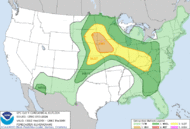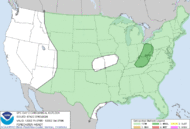| Backed |
Winds which shift in a counterclockwise direction with time at a given location (e.g. from southerly to southeasterly), or change direction in a counterclockwise sense with height (e.g. westerly at the surface but becoming more southerly aloft). The opposite of veering winds.
In storm spotting, a backing wind usually refers to the turning of a south or southwest surface wind with time to a more east or southeasterly direction. Backing of the surface wind can increase the potential for tornado development by increasing the directional shear at low levels.
|
| Boundary |
A boundary or transition zone between two air masses of different density, and thus (usually) of different temperature. A moving front is named according to the advancing air mass, e.g., cold front if colder air is advancing.
|
| CAPE |
Convective Available Potential Energy. A measure of the amount of energy available for convection. CAPE is directly related to the maximum potential vertical speed within an updraft; thus, higher values indicate greater potential for severe weather. Observed values in thunderstorm environments often may exceed 1000 joules per kilogram (J/kg), and in extreme cases may exceed 5000 J/kg.
However, as with other indices or indicators, there are no threshold values above which severe weather becomes imminent. CAPE is represented on an upper air sounding by the area enclosed between the environmental temperature profile and the path of a rising air parcel, over the layer within which the latter is warmer than the former. (This area often is called positive area.)
|
| Dryline |
A boundary separating moist and dry air masses, and an important factor in severe weather frequency in the Great Plains. It typically lies north-south across the central and southern high Plains states during the spring and early summer, where it separates moist air from the Gulf of Mexico (to the east) and dry desert air from the southwestern states (to the west). The dry line typically advances eastward during the afternoon and retreats westward at night. However, a strong storm system can sweep the dry line eastward into the Mississippi Valley, or even further east, regardless of the time of day. A typical dry line passage results in a sharp drop in humidity (hence the name), clearing skies, and a wind shift from south or southeasterly to west or southwesterly. (Blowing dust and rising temperatures also may follow, especially if the dry line passes during the daytime. These changes occur in reverse order when the dry line retreats westward. Severe and sometimes tornadic thunderstorms often develop along a dry line or in the moist air just to the east of it, especially when it begins moving eastward.
|
| Front |
A boundary or transition zone between two air masses of different density, and thus (usually) of different temperature. A moving front is named according to the advancing air mass, e.g., cold front if colder air is advancing.
|
| H85 |
Height of the 850 millibar level
|
| Hodograph |
A polar coordinate graph which shows the vertical wind profile of the lowest 7000 meters of the atmosphere. These plots are used to determine the advection patterns aloft, whether a thunderstorm will rotate, and the type of thunderstorms that you will likely see that day.
|
| Instability |
The tendency for air parcels to accelerate when they are displaced from their original position; especially, the tendency to accelerate upward after being lifted. Instability is a prerequisite for severe weather - the greater the instability, the greater the potential for severe thunderstorms.
|
| Lapse Rate |
The rate of change of an atmospheric variable, usually temperature, with height. A steep lapse rate implies a rapid decrease in temperature with height (a sign of instability) and a steepening lapse rate implies that destabilization is occurring.
|
| Millibar |
A unit of atmospheric pressure equal to 1/1000 bar, or 1000 dynes per square centimeter
|
| NWS |
|
| Shear |
Variation in wind speed (speed shear) and/or direction (directional shear) over a short distance within the atmosphere. Shear usually refers to vertical wind shear, i.e., the change in wind with height, but the term also is used in Doppler radar to describe changes in radial velocity over short horizontal distances.
|
| SPC |
|
| Supercell |
Short reference to Supercell Thunderstorm; potentially the most dangerous of the convective storm types. Storms possessing this structure have been observed to generate the vast majority of long-lived strong and violent (F2-F5) tornadoes, as well as downburst damage and large hail. It is defined as a thunderstorm consisting of one quasi-steady to rotating updraft which may exist for several hours.
|
| Triple point |
The intersection point between two boundaries (dry line, outflow boundary, cold front, etc.), often a focus for thunderstorm development. Triple point also may refer to a point on the gust front of a supercell, where the warm moist inflow, the rain-cooled outflow from the forward flank downdraft, and the rear flank downdraft all intersect; this point is a favored location for tornado development (or redevelopment).
|



 Fediverse (Mastodon)
Fediverse (Mastodon)
 Bluesky
Bluesky


